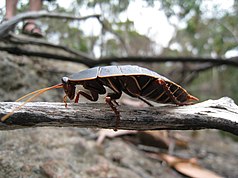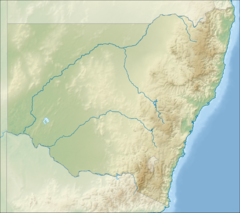Dharawal National Park
| Dharawal National Park | ||
|---|---|---|
| Polyzosteria limbata | ||
|
|
||
| Location: | New South Wales , Australia | |
| Next city: | 65 km southwest of Sydney | |
| Surface: | 65.08 km² | |
| Founding: | 2012 | |
| Lepyrodia scariosa | ||
The Dharawal National Park (English Dharawal National Park ) is a 65 km² national park in New South Wales , Australia , about 65 km southwest of Sydney and 35 km northwest of Wollongong . This area was home to the Dharawal tribe of Aborigines , and ax tracks, rock drawings and pictures are still preserved in the park today.
history
The area of today's national park was designated as a water protection area by the Sydney Catchment Authority 70 years ago . The associated restrictions on use have largely preserved the landscape in its original state. In 1996 the area was declared a State Recreation Area before becoming a national park in March 2012. However, coal can still be mined underground in the area of the national park; two permits for BHP Coal are still valid on the western edge of the park.
Flora and fauna
Dharawal National Park is part of the Sydney Basin in which O'Hares Creek and Stokes Creek cut deep into the Hawkesbury sandstone plateau. The vegetation ranges from tall eucalyptus forests to low woodland to windswept heathland . There are also small areas with rainforest and swampy areas. Over 500 plant species are native to the national park and 17 species live in the catchment area of O'Hares Creek that are classified as endangered, rare or threatened. In addition, a large number of endangered animals live in the park. The swamps in particular offer a habitat for swamp wallabies , the eastern mountain kangaroos , predatory pouches , white-eyed honey-eaters , frogs , crayfish and many species of insects .
Web links
- Official site of the park (English)
Individual evidence
- ^ Official website of the park (Culture and History). DECCW , accessed April 13, 2012 .
- ^ Official website of the park (Landscape and Geology). DECCW , accessed April 13, 2012 .
- ^ Official website of the park (native vegetation). DECCW , accessed April 13, 2012 .
- ^ Official website of the park (Native animals). DECCW , accessed April 13, 2012 .


